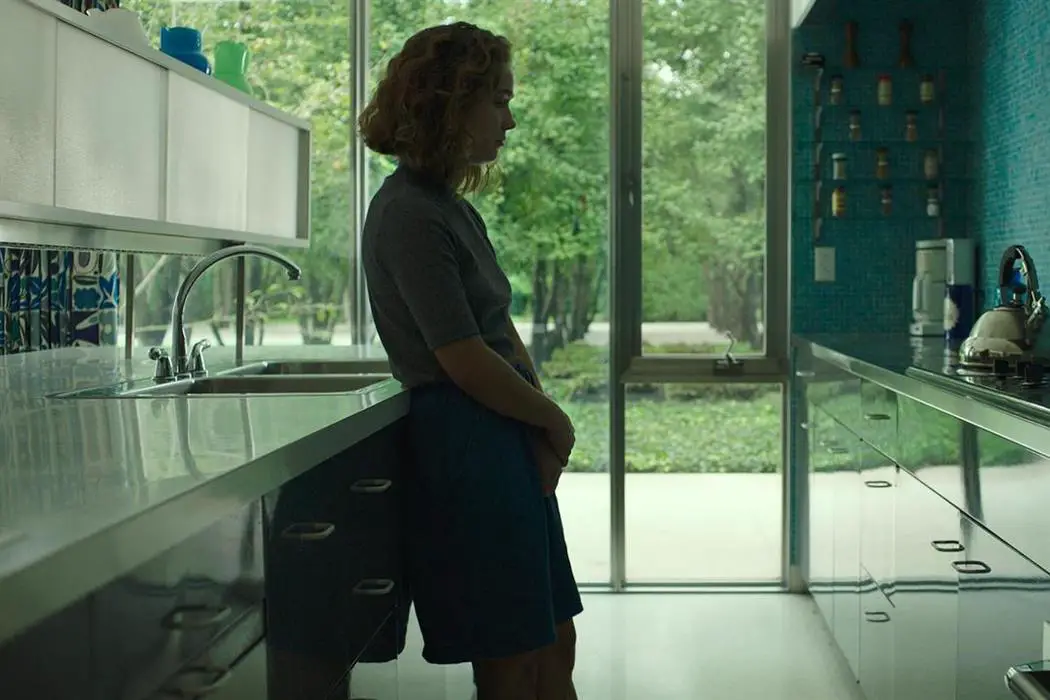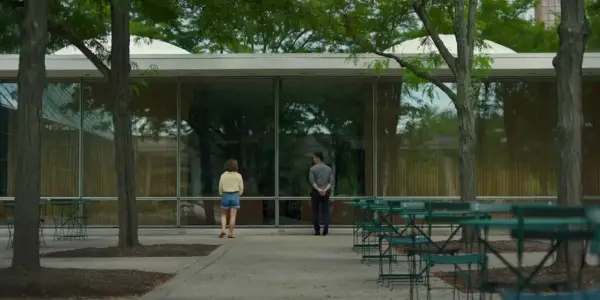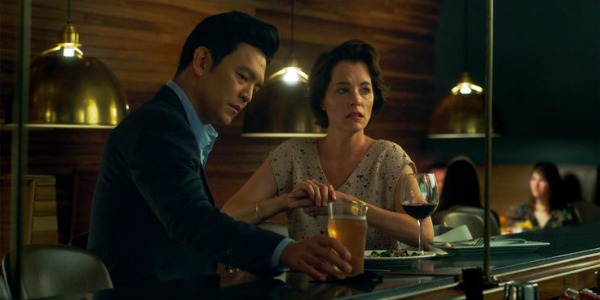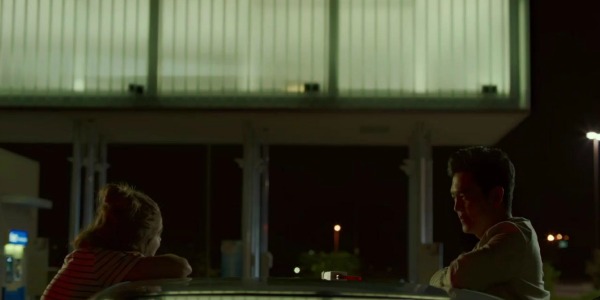COLUMBUS: Art Forms Converge In A Stunning Debut

Alex is a film addict, TV aficionado, and book lover.…
There’s a bridge featured in Columbus that is a ubiquitous part of my life. I drive over it every time I visit my family, and despite the striking red supports, I never thought much of it. It’s a magnificent bridge surrounded by chain stores and the decay of a blue collar town, and the reason for placing such a beautiful thing in the most mundane of places is at the very heart of Columbus.
The film is ostensibly about two people crossing paths in the small town of Columbus, Indiana. One, John Cho’s Jin, has come to see his ailing father. The other, Haley Lu Richardson’s Casey, has been stuck there her whole life. Both are in holding patterns, and they wile away the time visiting the city’s impressive array of modern architecture.
It’s a light plot that’s window dressing for a hypnotic meditation on time, responsibility, and art, reminiscent of Sofia Coppola’s Lost in Translation and Abbas Kiarostami’s Certified Copy. It’s got more rough edges than either of those movies, but such an ambitious and largely successful outing from first-time filmmaker Kogonada deserves wholehearted applause.
The Role of Art
Kogonada has long been making video essays for the Criterion Collection and others, breaking down the work of masters to explore how they communicated an idea. Considering that, it’s unsurprising to see him drawn to the intersection of art and consumer, particularly when he stumbled upon the strange relationship that occurs in the city of Columbus.

From the opening shot, it’s apparent that Kogonada isn’t just showing an appreciation for the modernist buildings created by architects like I.M. Pei and Eero Saarinen, but incorporating their aesthetics into his film. The clean lines are used to create striking frames, to draw the audience through a scene, and to quite literally foreshadow the parallels between Jin and Casey. Glass, that ever-present feature of modern architecture, is also heavily used to show self-reflection and observation of others, especially in a lovely scene where Jin presses Casey to describe why she adores a particular building.
There are times when the characters talk blatantly about concepts of architecture and literature that are a little too on the nose, and this penchant for audience hand-holding bleeds into several aspects of the film. It’s a shame, because the movie is so layered with subtle suggestions that these moments are largely unnecessary.
Some talk of principles and effect are needed, though, as the film is as much about the role art plays in everyday life as it is about anything else. Most of this is done through the lens of architecture, but the way Kogonada establishes an interplay between the buildings and his film suggests that any art form can provide these services. See what I mean about layers?
What to Do About Family
As Jin and Casey wander, their conversations often turn to why they are stuck in Columbus, and all roads lead back to family. Jin’s father was in town to give a talk on architecture, and now it’s unclear if he’ll leave alive, while Casey stays to help her mother recover from drug addiction. Each have a task in this place, but Jin is far more reluctant about his role.

There’s a sense that John Cho has been waiting for a mournful, complicated role like this, and now that he’s finally been given the opportunity, he nails every aspect of a forgotten, beleaguered son. As the older and more worn down of the pair, his character is less expressive about his situation, but Cho lets you see the weight Jin carries with every methodical movement. His performance is one of small shifts in rigidity and tone, the perfect counterpoint to the energy Richardson brings to Casey.
The bright architect nerd loves her town and the opportunities it affords her, particularly when it comes to hobnobbing with visiting aficionados. She rambles about building after building with an infectious passion that Richardson wonderfully transitions into something a bit darker. The moments she has with Jin are respites from responsibility, but it becomes clear that they may not be enough to sustain her.
Both Jin and Casey are faced with the question of staying or going, and the movie isn’t so pat that it gives one definitive answer. The marvelous performances by Cho, Richardson, Michelle Forbes as Casey’s mother, and Parker Posey as a longtime friend of Jin’s allows the eventual resolution to feel satisfying and more than a little heartbreaking.
Lost in Time
The whole film, in a sense, takes place in a reverie while these characters make their decisions, and from the beginning the film pulls you out of the standard progression of time. Establishing scenes are cut to show almost imperceptible jumps during Casey’s setup while Jin’s scenes spill into one another, suggesting a disorientation that later proves key to understanding his attraction to Casey.

These are clever tricks that lull you into the film’s pensive mood, and like the best of these kinds of films, leaves you suspended along with the characters. Without it, most people would never abide such a slow film. They wouldn’t be attentive enough to see everything that is going on, to take in all the cues Kogonada is dropping, and to get just how important this moment is to each of these characters’ lives.
That you come to care so much about this pair is because you’ve stopped to observe them, just like Casey fell in love with architecture when she stopped to observe the buildings around her. In a way, the film is an argument for slowing down, for taking a moment to solve a problem or appreciate what is in front of you. In today’s world, that’s kind of radical advice, but it’s advice worth taking.
Columbus: Conclusion
Kogonada put his deep film knowledge to good use in this stunning debut, delivering a movie with a perspective and message that stands out from the crowd. It’s rare for a film to have this much to say and to say it in such a gentle manner. Get lost in Columbus. You won’t regret it.
What are some of your favorite slow, deliberate films? What do you think are key to making these films work? Let us know in the comments!
Columbus is out in limited release in the U.S. and is expanding nationwide. Further release dates are not currently known.
Does content like this matter to you?
Become a Member and support film journalism. Unlock access to all of Film Inquiry`s great articles. Join a community of like-minded readers who are passionate about cinema - get access to our private members Network, give back to independent filmmakers, and more.
Alex is a film addict, TV aficionado, and book lover. He's perfecting his cat dad energy.












